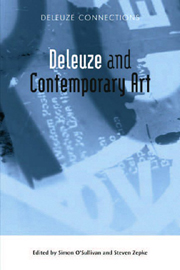Book contents
- Frontmatter
- Contents
- Acknowledgements
- List of Illustrations
- Introduction: Deleuze and Guattari and Contemporary Art
- POLITICS
- THE AESTHETIC PARADIGM
- 5 Capitalism and Schizophrenia and Consensus: Of Relational Aesthetics
- 6 The Practice and Anti-Dialectical Thought of an ‘Anartist’
- 7 Ethologies of Software Art: What Can a Digital Body of Code Do?
- 8 Fractal Philosophy (And the Small Matter of Learning How to Listen): Attunement as the Task of Art
- SCENES AND ENCOUNTERS
- TECHNOLOGIES
- Notes on Contributors
- Index
5 - Capitalism and Schizophrenia and Consensus: Of Relational Aesthetics
from THE AESTHETIC PARADIGM
Published online by Cambridge University Press: 12 September 2012
- Frontmatter
- Contents
- Acknowledgements
- List of Illustrations
- Introduction: Deleuze and Guattari and Contemporary Art
- POLITICS
- THE AESTHETIC PARADIGM
- 5 Capitalism and Schizophrenia and Consensus: Of Relational Aesthetics
- 6 The Practice and Anti-Dialectical Thought of an ‘Anartist’
- 7 Ethologies of Software Art: What Can a Digital Body of Code Do?
- 8 Fractal Philosophy (And the Small Matter of Learning How to Listen): Attunement as the Task of Art
- SCENES AND ENCOUNTERS
- TECHNOLOGIES
- Notes on Contributors
- Index
Summary
Populist Prologue
And no doubt the combat appears as a combat against … But more profoundly, it is the combatant himself who is the combat: the combat is between his own parts, between the forces that either subjugate or are subjugated, and between the powers that express these relations of forces.
Gilles Deleuze, Essays Critical and ClinicalThere is an amusing article written some ten years ago by the French art critic Eric Troncy, entitled ‘The Stockholm Syndrome’. Later revisited by Baudrillard, through Troncy, ‘Stockholm syndrome’ referred to the paradoxical relations linking socio-cultural consensus to the aesthetics of an avant-garde reduced to the most fashionable ‘look’ of the nineties. The fact that this was to end badly – today, Troncy writes quirky apologetics for reality TV as contemporary art's most radical readymade, by virtue of its renunciation of all claim to the elitist status of the artwork (the ‘everyday’ perfect crime!) – makes the article's opening lines all the more delectable: I quote, appropriating this ephemeral moment of lucidity: ‘What is at stake is nothing less than the evacuation of revolutionary desire through the small door of communication, at the same time as the draining of alterity into the great pit of the same’ (Troncy 1998: 49).
I could not think of a better introduction to the provocation that leads me to present a kind of critical and clinical treatment of relational aesthetics in the murky light of Populism, which we could envisage as signalling the dawn of a sleepless night, of the kind recently organised by Nicolas Bourriaud and Jérôme Sans in Paris, precisely under the heading Nuit blanche (or White Night Event).
- Type
- Chapter
- Information
- Deleuze and Contemporary Art , pp. 85 - 99Publisher: Edinburgh University PressPrint publication year: 2010

